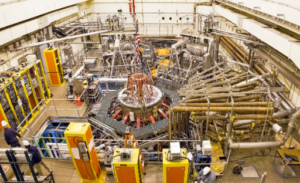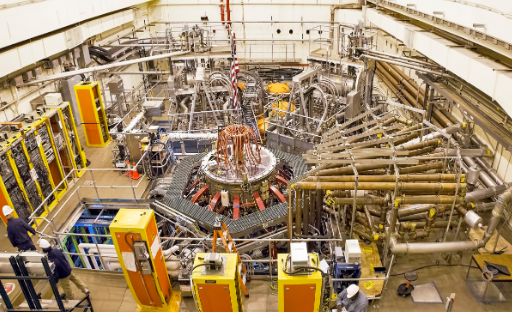Plasma Physics: A New Frontier in Nuclear Fusion Research
Nuclear fusion, the process that powers the stars, has long been regarded as the ultimate solution to humanity’s energy challenges. Unlike fossil fuels or even nuclear fission, fusion promises abundant, clean, and nearly limitless energy without the associated risks of long-lived radioactive waste or greenhouse gas emissions. At the heart of fusion research lies plasma physics—a field dedicated to understanding and controlling the behavior of plasma, the fourth state of matter.
This article explores the role of plasma physics as a groundbreaking frontier in nuclear fusion research, highlighting its challenges, advancements, and future potential in reshaping global energy systems.
Understanding Plasma and Its Role in Nuclear Fusion
Plasma is often referred to as the fourth state of matter, distinct from solids, liquids, and gases. It is formed when a gas is heated to extreme temperatures, causing the atoms to ionize, creating a mixture of free electrons and positively charged ions. This ionized state is highly reactive and plays a crucial role in enabling nuclear fusion.
In a fusion reactor, plasma must be heated to millions of degrees—hotter than the core of the Sun—to overcome the natural repulsion between atomic nuclei. Once these nuclei collide and fuse, they release immense amounts of energy. The challenge lies in creating and maintaining these extreme conditions on Earth in a controlled and sustained manner.
Advances in Plasma Physics for Fusion Research
Significant advancements in plasma physics are driving progress in nuclear fusion research, particularly in understanding plasma behavior, optimizing confinement, and developing advanced reactor designs.
1. Magnetic Confinement Fusion
Magnetic confinement is one of the most promising approaches to achieving fusion. Devices such as tokamaks and stellarators use powerful magnetic fields to contain the superheated plasma, preventing it from coming into contact with reactor walls.
- Tokamaks: These doughnut-shaped reactors use magnetic fields to confine plasma in a toroidal (ring-like) shape. The International Thermonuclear Experimental Reactor (ITER) is a prime example of a tokamak pushing the boundaries of fusion technology.
- Stellarators: Stellarators use twisted magnetic coils to achieve stable plasma confinement without the need for induced electrical currents, offering an alternative to tokamak designs.
2. Inertial Confinement Fusion (ICF)
In ICF, powerful lasers or particle beams are used to compress and heat tiny pellets of fusion fuel, creating the conditions necessary for nuclear fusion. Advances in laser technology, such as those seen at the National Ignition Facility (NIF), have brought researchers closer to achieving ignition—a critical milestone where fusion reactions become self-sustaining.
3. Plasma Instabilities and Turbulence
Understanding and controlling plasma instabilities is one of the biggest challenges in fusion research. Turbulence within the plasma can lead to energy losses, reducing the efficiency of the fusion process. Researchers are using advanced diagnostics, simulations, and machine learning to study and mitigate these instabilities.
4. High-Temperature Superconductors (HTS)
HTS materials are revolutionizing the design of magnets used in fusion reactors. These materials enable the creation of stronger magnetic fields, improving plasma confinement and allowing for more compact and efficient reactor designs.
5. Plasma Heating Techniques
Heating plasma to fusion-relevant temperatures is critical. Several methods are employed, including:
- Neutral Beam Injection (NBI): High-energy particles are injected into the plasma to transfer energy.
- Radiofrequency (RF) Heating: Electromagnetic waves resonate with plasma particles, increasing their energy.
- Ohmic Heating: Electric currents within the plasma generate heat through resistance.
Challenges in Plasma Physics and Fusion Research
While the potential of nuclear fusion is immense, several challenges must be overcome to make it a viable energy source:
- Energy Input vs. Output: Achieving a net-positive energy gain—where the energy produced by fusion exceeds the energy required to sustain it—remains a major hurdle.
- Plasma Stability: Maintaining stable plasma confinement without disruptions is critical for sustained fusion reactions.
- Material Durability: Reactor walls must withstand extreme heat, radiation, and neutron bombardment without degrading over time.
- Cost and Scalability: Fusion reactors must become economically viable and scalable to compete with existing energy technologies.
Future Directions in Plasma Physics and Fusion Energy
The future of nuclear fusion research lies in continued innovation and collaboration across disciplines. Key areas of focus include:
- Next-Generation Reactors: Projects like ITER and the U.S.-based SPARC reactor aim to demonstrate the feasibility of sustained fusion power generation.
- Advanced Diagnostics: High-precision tools and sensors are being developed to monitor plasma behavior in real-time, enabling better control and optimization.
- Artificial Intelligence (AI): AI and machine learning are playing a growing role in predicting and mitigating plasma instabilities, as well as optimizing reactor performance.
- Hybrid Approaches: Combining magnetic and inertial confinement techniques may lead to breakthroughs in achieving stable and efficient fusion.
- Global Collaboration: International partnerships are accelerating progress, with countries pooling resources, knowledge, and expertise to advance fusion technology.
Plasma Physics: A Catalyst for Sustainable Energy
The promise of nuclear fusion as a clean, sustainable, and nearly inexhaustible energy source makes it one of the most exciting frontiers in science and engineering. Plasma physics lies at the core of this pursuit, offering insights and innovations that are paving the way toward practical fusion energy.
While challenges remain, the strides made in plasma physics and fusion research are bringing us closer to realizing the dream of harnessing the power of the stars. As efforts continue, nuclear fusion could become the cornerstone of a sustainable energy future, transforming the way we power our world for generations to come.

Also Read :
- The Science Behind MRI: A Deep Dive into Magnetic Resonance Imaging
- How MRI Technology is Transforming Medical Diagnostics
- MRI-Based Radiomics in Neurosurgical Outcome Prediction
- Electrical Engineering : Trends in Power Generation and Distribution
- Prime Technology 2024
